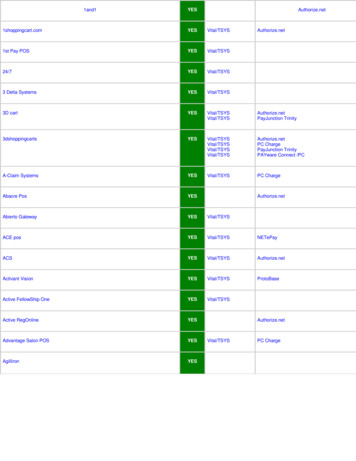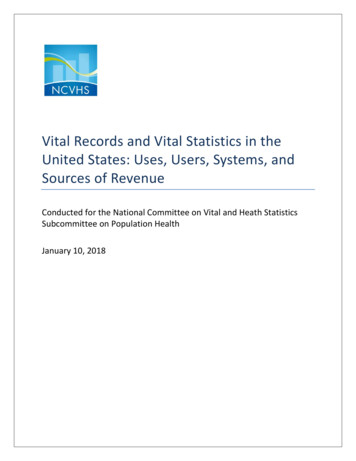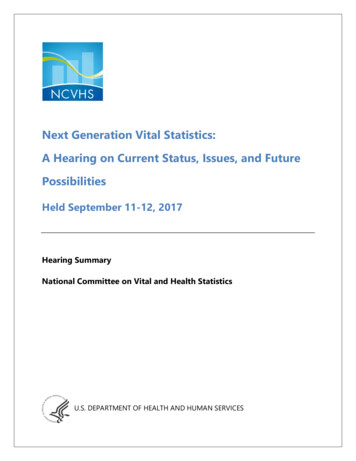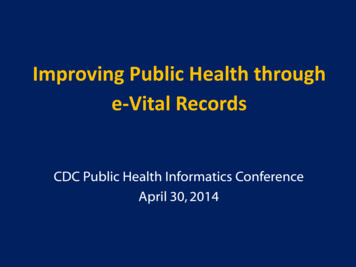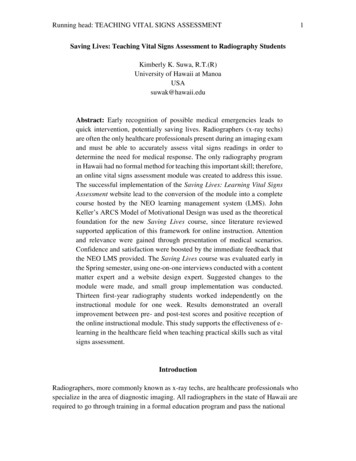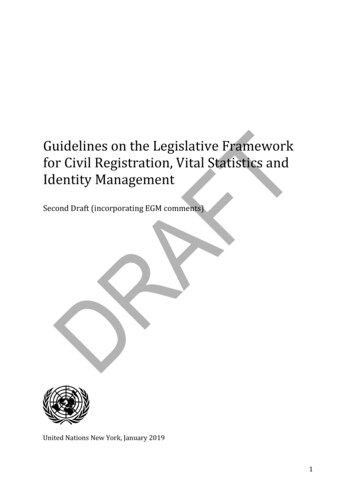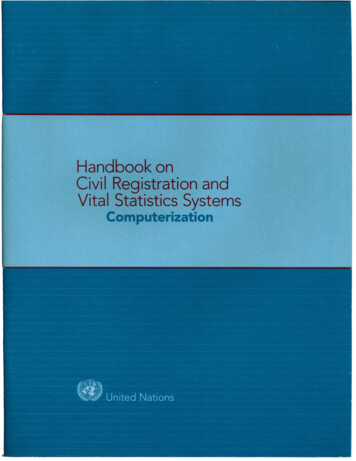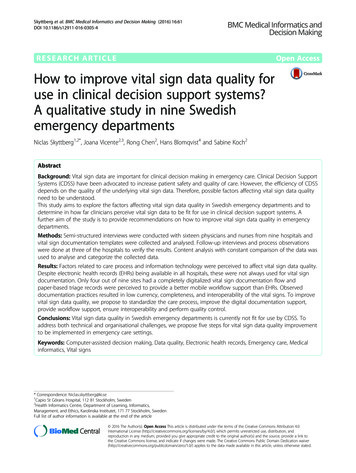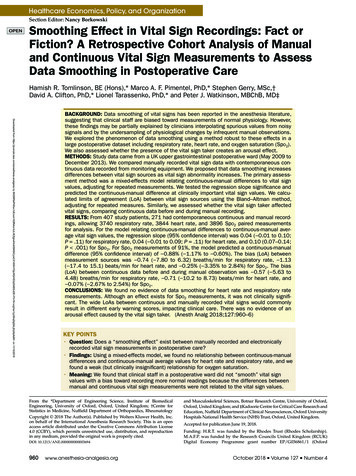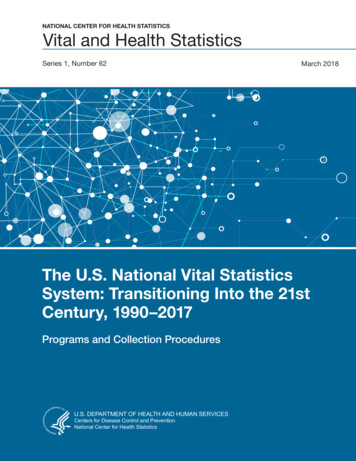
Transcription
NATIONAL CENTER FOR HEALTH STATISTICSVital and Health StatisticsSeries 1, Number 62March 2018The U.S. National Vital StatisticsSystem: Transitioning Into the 21stCentury, 1990–2017Programs and Collection ProceduresU.S. DEPARTMENT OF HEALTH AND HUMAN SERVICESCenters for Disease Control and PreventionNational Center for Health Statistics
Copyright informationAll material appearing in this report is in the public domain and may bereproduced or copied without permission; citation as to source, however, isappreciated.Suggested citationVentura SJ. The U.S. National Vital Statistics System: Transitioning into the 21stcentury, 1990–2017. National Center for Health Statistics. Vital Health Stat 1(62).2018.Library of Congress Cataloging-in-Publication DataNames: National Center for Health Statistics (U.S.), issuing body.Title: The U.S. National Vital Statistics System : transitioning into the21st century, 1990-2017.Other titles: Vital and health statistics. Ser. 1, Programs and collectionprocedures ; no. 62. DHHS publication ; no. 2018-1338. 0276-4733Description: Hyattsville, Maryland : U.S. Department of Health and HumanServices, Centers for Disease Control and Prevention, National Center forHealth Statistics, March 2018. Series: Vital and health statistics,series 1, program and collection procedures ; number 62 Series: DHHS pub; number 2018-1338 Includes bibliographical references.Identifiers: LCCN 2018002222 ISBN 9780840606884 (pbk.) ISBN 0840606885(pbk.)Subjects: MESH: National Vital Statistics System (U.S.) Vital Statistics Statistics as Topic--trends Data Collection--methods United StatesClassification: LCC RA407.3 NLM W2 A N148va no.62 2018 DDC 614.4/273--dc23 LC record available at https://lccn.loc.gov/2018002222For sale by the U.S. Government Printing OfficeSuperintendent of DocumentsMail Stop: SSOPWashington, DC 20402–9328Printed on acid-free paper.
Vital and Health StatisticsSeries 1, Number 62The U.S. National Vital StatisticsSystem: Transitioning Into the21st Century, 1990–2017Programs and Collection ProceduresU.S. DEPARTMENT OF HEALTH AND HUMAN SERVICESCenters for Disease Control and PreventionNational Center for Health StatisticsHyattsville, MarylandMarch 2018DHHS Publication No. (PHS) 2018–1338
National Center for Health StatisticsCharles J. Rothwell, M.S., M.B.A., DirectorJennifer H. Madans, Ph.D., Associate Director for ScienceDivision of Vital StatisticsDelton Atkinson, M.P.H., M.P.H., P.M.P., DirectorHanyu Ni, Ph.D., M.P.H., Associate Director for Science
tion11989 Revisions of the U.S. Standard Certificates and Reports and Evaluations of the FormsEvaluation of the 1989 CertificatesRevision Recommendations for the 2003 CertificatesEvaluating and Testing the Proposed Revised Certificates and Associated Materials2233Implementation of the 2003 Standard CertificatesBackgroundBudgetary and Implementation Challenges445Challenges in Implementing the 2003 RevisionsConsequences of These ChallengesDelay in Approval to Use the New Data Items on CertificatesOngoing Challenges to the Vital Statistics Cooperative Program6699Reengineering the National Vital Statistics SystemThe Concept of MoVERSReengineering of Internal Processing Systems101011Coding Cause of Death for MortalityInternational Classification of Diseases (ICD)Mortality Coding SystemEvaluation of Iris Proprietary Software11111212Transmitting Vital Statistics Data From the States to NCHS12Improving Timeliness of Birth and Death Statistical Data With “Preliminary” Releases13Using Technology to Improve Timeliness of Vital Statistics Data, Especially MortalityMortality Surveillance Facilitates Continued Improvement in Timeliness1415Evaluating and Improving Birth Data QualityEvaluation of Worksheets and Comparison With Hospital Birth Records DataImprovements in the Measurement of Gestational AgeBirth Data Quality WorkgroupOther Initiatives to Enhance Vital Statistics Data Quality1515161618Micro-data Files: Data Dissemination Tools and StrategiesContent and Availability of Vital Statistics DataData Sets181819New Strategies to Enhance Availability and Utility of Vital Statistics Data SetsVital Statistics Rapid Release Program Showcased in New Online ReleasesData Visualization GalleryOther Data Access Tools22222222Publication of Tabulated and Descriptive Analytic Reports23iii
Transitioning Vital Statistics From a “Good” to a “Great” System . . . . . . . . . . . . .Implementing a Cooperative Agreement with NAPHSIS . . . . . . . . . . . . . . . .Implementing a Federal–State Good to Great Partnership . . . . . . . . . . . . . . . .Development of the 2012–2016 Contract for the Vital Statistics Cooperative Program .Workforce Development . . . . . . . . . . . . . . . . . . . . . . . . . . . . . . . . .Other Initiatives Focused on Improving Vital Statistics Data . . . . . . . . . . . . . . 23. 23. 23. 24. 25. 26Envisioning the Future of Vital Statistics . . . . . . . . . . . . . . . . . . . . . . . . . . . . . . . . . . . . . . . . . . . . . . . 27References . . . . . . . . . . . . . . . . . . . . . . . . . . . . . . . . . . . . . . . . . . . . . . . . . . . . . . . . . . . . . . . 29Table. Vital statistics history timeline, 1940–2017 . . . . . . . . . . . . . . . . . . . . . . . . . . . . . . . . . . . . . . . . . . 37Appendix I. Initial Decisions in the Mid-1990s to Address Resource Limitations in the National VitalStatistics System . . . . . . . . . . . . . . . . . . . . . . . . . . . . . . . . . . . . . . . . . . . . . . . . . . . . . . . . . . . 42Items Dropped From Data Sets . . . . . . . . . . . . . . . . . . . . . . . . . . . . . . . . . . . . . . . . . . . . . . . . . . . 42Collection of Abortion, Marriage, and Divorce Data Ended . . . . . . . . . . . . . . . . . . . . . . . . . . . . . . . . . . . . 42Appendix II. Mortality Medical Coding System . . . . . . . . . . . . . . . . . . . . . . . . . . . . . . . . . . . . . . . . . . . 43Appendix III. International Classification of Diseases (ICD). . . . . . . . . . . . . . . . . . . . . . . . . . . . . . . . . . . . . 44Appendix IV. Collaborative Efforts Based on Real-time Mortality Surveillance . . . . . . . . . . . . . . . . . . . . . . . . . . . 45Appendix V. Items Deleted From the National Fetal Death Data Set . . . . . . . . . . . . . . . . . . . . . . . . . . . . . . . . . 46Appendix VI. Followback Surveys . . . . . . . . . . . . . . . . . . . . . . . . . . . . . . . . . . . . . . . . . . . . . . . . . . 47Appendix VII. Effort by National Academies to Generate Attention to Current and EmergingUses of Vital Statistics Data . . . . . . . . . . . . . . . . . . . . . . . . . . . . . . . . . . . . . . . . . . . . . . . . . . . . . . 48Appendix TablesI.Revision status of each jurisdiction according to when they implemented the revised birth certificate. .II.Revision status of each jurisdiction according to when they implemented the revised death certificate .III.Revision status of each jurisdiction according to when they implemented the revised fetal death reportIV.Items included on the U.S. Standard Certificate of Live Birth, by year revised. . . . . . . . . . . . . .V.Items included on the U.S. Standard Certificate of Death, by year revised. . . . . . . . . . . . . . . .VI.Items included on the U.S. Standard Report of Fetal Death, by year revised . . . . . . . . . . . . . . .495051526064Appendix FiguresI.Implementation of the 2003 revised birth certificate . . . . . . . . . . . . . . . . . . . . .II.Implementation of the 2003 revised death certificate . . . . . . . . . . . . . . . . . . . . .III.State and Territorial Exchange of Vital Events (STEVE) certifications, updated March 2018IV.Electronic death registration processing status, updated February 2018 . . . . . . . . . . .V.Electronic birth registration status, updated February 2018 . . . . . . . . . . . . . . . . . .7071727374iv.
PrefaceThe National Vital Statistics System(NVSS) is a decentralized, cooperativesystem comprised of 57 registrationareas (i.e., the 50 states, the Districtof Columbia, New York City, and fiveterritories: Puerto Rico, the VirginIslands, Guam, American Samoa, andthe Commonwealth of the NorthernMarianas). Overall coordination andguidance for NVSS is provided by theNational Center for Health Statistics(NCHS) and its predecessor agencies.The system is an indispensablecomponent of the U.S. public healthsystem and has been since the beginningof the 20th century. Having detailed datafor every one of the nearly 4 millionbirths and 2.5 million deaths annuallyin the United States makes it possibleto track indicators of health status forthe population at the national, state,and local levels, including disparitiesby age, sex, race and ethnicity, anddetailed geography. Infant mortality,access to prenatal care, maternal riskfactors and pregnancy history, teen birthrates, changes in causes of death andrankings of causes, and life expectancypatterns are among the key indicatorsavailable from vital statistics. The dataare invaluable for identifying populationsat risk, program planning, and developinginitiatives to target health disparities, toname a few. Identifying rare causes ofdeath and the disparate impact of healthconditions on mothers and decedents isalso possible with vital statistics data.These data are also foundational fordeveloping population estimates andprojections for the country, for states, andfor local areas. NVSS has been describedin detail elsewhere (1–4). Uniformityand standardization of national statisticshave been achieved through a numberof mechanisms, including definitionsand reporting requirements, andrecommended laws and regulations (e.g.,the Model State Vital Statistics Act andRegulations). The standard certificateshave been the principal means ofachieving uniformity in the informationto be collected and on which nationalstatistics are based.The Vital Statistics CooperativeProgram (VSCP) has been the foundationfor the federal–state partnership inproducing vital statistics since 1973 (1).NCHS has engaged in contracts with thejurisdictions to obtain, through fundingsupport, individual record data forbirths, deaths (demographic and medicalinformation), and fetal deaths. Thecontract for the last half of the 1990s wasthe first to set the stage for automation,improved timeliness, and the innovativedata products described in this report.Until the mid-1990s, records formarriages, divorces, and abortions werealso included in VSCP. The reportingareas for these events, however, neverincluded all states and registration areas.The purpose of this report is toupdate the previous histories, publishedfirst in 1954 and then in 1997 (1,2). Thedevelopments and changes over the pasttwo decades have been extraordinaryand far-reaching. While some of thebroad outlines of these activities wereenvisioned back in the mid-1990s,the full scope and breadth were notanticipated. The history during thisrecent period encompassed changesand challenges in a vast array of areas,and many were occurring concurrentlyon different tracks. Thus, this report isorganized more by general topic area and,within topics, chronologically. To aid thereader in reviewing and interpreting therecent history, this report is accompaniedby a timeline (Table). The timeline listsimportant activities and milestonesin all aspects of the history of NVSSand related programs chronologically,beginning in the mid-20th century toprovide greater context. Readers canrefer to significant milestones in thetimeline and then to the report for moredetails. For the early decades, additionalinformation is available elsewhere (1,2).Readers can also use the timeline to gaina greater understanding of how variousevents and activities intersected andoverlapped. Additional background andcontext are provided in Appendices I–VIIand in supporting Appendix Tables I–VIand Appendix Figures I–V.Although not strictly part of NVSS,two programs, the National Survey ofFamily Growth and the natality andmortality followback surveys, are alsodiscussed briefly in this report. Bothprograms have provided importantinformation that has augmented NVSS.This report is based on extensiveinterviews with colleagues in NCHS’Division of Vital Statistics (DVS) (theorganizational unit within NCHS whereNVSS is housed) and retired DVS andNCHS staff, whose names are listedin the Acknowledgments, as well aspublished and unpublished materials fromNCHS and other sources. These sourcesare included in the reference section ofthe report. It is expected that the reportwill be useful to a wide audience in thepublic health, public policy, and researchcommunities seeking to understandhow the country’s vital statistics systemhas evolved in the last quarter centuryand how the information collectedand disseminated in the system can beinterpreted and analyzed. In addition, itis anticipated that the report will provideimportant context and background forcurrent NVSS program staff and for staffwho join the NVSS program in futureyears, as well as for state colleagues.Page v
AcknowledgmentsThe author is very grateful to CharlesRothwell, Director of the NationalCenter for Health Statistics (NCHS)and Delton Atkinson, Director of theDivision of Vital Statistics (DVS) inNCHS, for sharing their vision for thisreport and encouraging the preparationof the report. They wanted to have arecord of the numerous, far-reaching,and extensive changes that have occurredin the National Vital Statistics Programoverall and in DVS over the last 25 ormore years. The author also gratefullyacknowledges the helpful and thoughtfulcomments and suggestions on themanuscript by Charles Rothwell, DeltonAtkinson, and NCHS Associate Directorfor Science, Jennifer Madans, and forthe generous assistance with manuscriptpreparation provided by Hanyu Ni,Associate Director for Science, DVS.NCHS Director Rothwell and DVSDirector Atkinson enthusiasticallysupported the project and theparticipation of current and formerNCHS staff to share their expertise.Many persons within DVS contributedto the preparation of this report and todocumenting the events and decisionsmade over the years since 1990. Themanuscript was based in part onextensive interviews with current andformer NCHS staff over several monthsas well as historical materials that theyprovided. Specific acknowledgmentis made to the following contributorswho assisted in various ways, includinggenerously sharing their time andexpertise or carefully reviewing themanuscript: Farida Ahmad, RobertAnderson, Elizabeth Arias, DeltonAtkinson, Robert Bilgrad, Amy Branum,Anjani Chandra, Mary Anne Freedman,George Gay, Elizabeth Wilson Gregory,Bonita Gross, Brady Hamilton, DonnaHoyert, Lillian Ingster, Robert Israel,Chrissy Jarman, David Johnson, DavidJustice, Hetty Khan, Karen Knight,Kenneth Kochanek, Julia Kowaleski,Li (Leo) Lu, Jennifer Madans, JoyceMartin, Hanyu Ni, Michelle Osterman,Charles Rothwell, Charles Sirc, StevenSteimel, Paul Sutton, George Tolson,viRajesh Virkar, James Weed, and MichelleWilliamson. In addition, appreciation isextended to Raquel Brown and AndreaPrice, staff members with the NationalAssociation for Public Health Statisticsand Information Systems (NAPHSIS),who assisted with jurisdiction-specificinformation. Graphics were preparedby Donna Hoyert, Chrissy Jarman, andMichelle Osterman. Tables were preparedby George Tolson. The manuscript wasedited by Jen Hurlburt and typesettingwas done by Ebony Davis.
AbstractObjectivesThis report describes the history ofthe National Vital Statistics System,with a focus on the period 1990–2017.The vital statistics system is thecountry’s most enduring program ofdata collection on the health of thepopulation. It is based on informationreported on the certificates of birthsand deaths and reports of fetaldeaths, collected in each of the statesand independent registration areas.Over the last two decades, the vitalstatistics system has experiencedfar-reaching changes, and has shiftedin important ways to emphasize dataquality, timeliness, and analysis. Thechanges underlying these areas aredescribed.MethodsThis report is based on extensiveinterviews with current and formerstaff of the National Center for HealthStatistics’ (NCHS) Division of VitalStatistics, the organizational unit thathouses the National Vital StatisticsSystem. The report also includesinformation collected in numerouspublished and unpublished materialsfrom NCHS and other sources.To aid the reader in reviewing andinterpreting the recent history, thisreport is accompanied by a timeline.The timeline lists, chronologically,important activities and milestonesin all aspects of the history of theNational Vital Statistics System andrelated programs, beginning mid-20thcentury, to provide greater context.ConclusionsThe National Vital StatisticsSystem has experiencedextraordinary and far-reachingchanges since the early- to mid1990s. Data content, timeliness, andquality have improved significantlyand these changes have enhancedthe value of vital records fordescribing and documenting thehealth of the country’s population.Keywords: birth and deathcertificates fetal death reports reengineering vital statistics revisions of standard certificates analysis of vital statistics data Vital Statistics Cooperative ProgramThe U.S. National Vital StatisticsSystem: Transitioning Into the21st Century, 1990–2017by Stephanie J. Ventura, M.A.IntroductionWhen the last report on the vitalstatistics system was published in 1997(1), the National Center for HealthStatistics (NCHS) and the states wereon the cusp of revolutionary, thoughnot yet fully understood, changes inthe reporting, collection, analysis, anddissemination of vital statistics data.Electronic registration was alreadyunderway for births and in the veryearly stages for deaths. Almost 70%of births from more than one-half ofthe states that had or were developingand implementing electronic birthregistration systems (EBRS) wereregistered electronically in 1995 (1). Pilotstudies were underway for electronicdeath registration systems (EDRS),which were slower to develop. Deathregistration is more complicated becausedata are reported from multiple sources(i.e., funeral directors, physicians, andcoroners or medical examiners). Themain underlying principle for electronicsystems for vital records is that recordsshould be created, edited, coded,queried, and corrected at the source.These standards turned out to be guidingprinciples for the 2003 revisions of theU.S. Standard Certificates and Reportsthat were in the early planning stages inthe late 1990s.Concurrent with this transformationthough was the realization that thebasic vital registration systems still inwidespread use were based on outmodedregistration practices and structures, sothat even with the transition, at leastfor births to EBRS, the underlyingsystems and processes were antiquatedand were inconsistent with goals ofimproved data quality and timeliness,and efforts to facilitate real-time datalinkage capabilities. For example,early EBRS had limited capability forinteractive edits. Data transmitted wereinitially submitted from “standalone”systems in hospitals and the dataessentially had to be accepted and used“as is.” Hospitals updated their EBRSindividually. Thus, the data collectedwere not necessarily comparable acrosshospitals. Subsequently, the electronicsystems transitioned to being web-based.Within a jurisdiction, then, hospitals wereaccessing the same version of the EBRSsoftware. Thus, software problems hadwidespread consequences. The earlypromise of electronic systems continuedto be largely unmet. These underlyingchallenges were summarized by NCHSDirector Charles Rothwell (formerlyDirector of the Division of VitalStatistics) in his 2004 essay explainingthe issues and suggesting strategies toaddress the problems (5). This essaymakes it clear that although nearly adecade had already passed since theseissues initially received focused attention,and some progress had been achieved,major challenges in systems, culture, andfunding persisted. Examples of progressinclude the development of functionalrequirements for reengineered birthand death registration and the growthof collaborations among a number oforganizations working on these issues(e.g., Model Vital Events RegistrationSystem [MoVERS]; see section laterin this report). This situation was theimpetus for the National Academies’Committee on National Statistics toconvene a workshop on Vital Datafor National Needs in 2008 (4). Thisworkshop is discussed in Appendix VII.Page 1
Page 2 Series 1, No. 62As indicated, this period importantlycoincided with a shift in focus todata quality, with the goal that thedata produced be based on nationallycomparable collection systems, butconcerns about timeliness were ongoingand persistent. Three inextricably linkedissues in particular challenged theNational Vital Statistics System (NVSS)during this period: a) ensuring that datawere nationally comparable, b) focusingon data quality, and c) improving datatimeliness. The data quality concerns,initially raised in 1954 (1), wereespecially prominent for the medical andhealth data and reflected a strong beliefthat birth and death registration dataare crucial components, even buildingblocks, of public health informationsystems and could be used to provideessential health statistics for all levels ofgovernment, institutions, and the public.While the system was referred to as anational vital statistics system, it waswidely understood that vital statisticswere essentially health statistics.1989 Revisions ofthe U.S. StandardCertificates andReports andEvaluations of theFormsThe 1989 revisions of the birthcertificate and fetal death reportrepresented the first serious foray intoreporting increased medical and healthinformation (6). The use of checkboxeswas promoted as a way to improve theuniformity and comparability, and thusthe quality, of the data. Prior revisions ofthe certificates included items with openended response options, making it almostimpossible to compile uniform andcomparable data. However, soon after the1989 revisions were implemented, qualityconcerns abounded: The checkboxeswere said to be too vague and imprecise,not well-defined, and not uniformlyreported (3,7–14). Further, some itemswere deemed inappropriate for collectionon the certificates (e.g., alcohol useon the birth certificate and fetal deathreport were considered problematicbecause of the stigma associated with thissubstance) (3). To sum up, the mid-1990smarked a period when NCHS and theregistration areas were acknowledgingand responding to the inadequacies oftheir systems to meet the timeliness andquality challenges of these systems; wereexploring and developing electronic vitalregistration systems; and were identifyingstrategies to meet the demands forhigh-quality, reliable, consistent,comparable, and timely vital statisticsdata for important public health andpublic policy needs. The challenges andthe responses developed to address themare detailed in the next sections.revision process would be implementedafter International Classification ofDiseases (ICD–10) coding had begun fordeaths (in 1999) (15) and any problemsassociated with the millennium transitionto the year 2000 (known as Y2K)that could affect dates and other legalelements had been addressed (3). Largelybecause of these factors, although itwas initially hoped that the evaluationactivity would result in revisions takingeffect in the late 1990s, the revisionactivity actually culminated in standardcertificates that were adopted in 2003 asdescribed in this report.The evaluation objectives and theevaluation criteria are reprinted here fromthe Panel Report (3):Evaluation of the 1989Certificates Review the current certificates,prepare a report to assess theusefulness of the existing data items,and determine how the quality of thedata can be improved and collectedfor statistical and legal purposes; Identify unmet data needs anddetermine if the standard certificatesare the most appropriate place tocollect such data. This includedattempting to identify future dataneeds for the next 15–20 years; and Make recommendations for thecontent, format, and standarddefinitions of the proposed standardcertificates. This task was to beaccomplished with the understandingthat a “certificate” is no longerrepresented by the piece of paper onwhich the data are collected, but bya standard vital statistics databasewith a strong emphasis on electronic,automated data collection.Consistent with previous revisions,the first steps taken in exploring revisionsof the standard certificates for the 1990sand forward were to evaluate the 1989revisions, including their effectiveness,and from that launching pad, to examinehow the certificates and the processescould be improved. These evaluationswere inaugurated with a planning phasethat began in 1994 and continued throughthe rest of the 1990s. The overarchingactivities were facilitated under the Panelto Evaluate the (1989) U.S. StandardCertificates (3). NCHS provided resourcesupport and coordination, and state vitalregistration executives and medicaland health experts provided Panelleadership. The 1989 revision-basedevaluations began with surveys of stateregistrars and vital statistics executiveson their views on items to keep anditems to discard, and items that theirjurisdictions recommended adding to theU.S. standard certificates. At the earlystages, in 1998, the decision was madeto evaluate (i.e., revise) only the birthand death certificates and the fetal deathreport; it was decided that the marriageand divorce certificates and the inducedtermination of pregnancy report shouldnot be revised (see later sections in thisreport, Appendix I, and reference 3). Itwas further agreed that the results of theEvaluation objectives:Evaluation criteria for review of existingand new items included: Is the item needed for legal, research,statistical, or public health programs? Is the item collectible withreasonable completeness andaccuracy? Is the vital statistics system the bestsource for this information?The Panel’s work to evaluate the1989 certificates continued throughthe 1990s until mid-2000. The Panel’s
Series 1, No. 62 Page 3deliberations are described in detailelsewhere (3).Revision Recommendationsfor the 2003 CertificatesThe changes in certificates between1989 and 2003 were substantial, farexceeding those for previous revisions.Major changes included the addition ofa number of items to the birth certificate(16), namely maternal morbidity;mother’s height and prepregnancyweight; women, infants, and children(WIC) food program participation;principal source of payment for thedelivery; infections present; breastfeedingstatus; and whether the infant was livingat the time of discharge from the birthfacility. The Panel also recommendedother substantive changes to the existingmedical and health information. Theseincluded enhancements to the smokingquestions, to capture smoking andquitting by trimester, for example, andsome item deletions. In addition, thePanel recommended new and modifieditems along with the addition of specificitems to facilitate data linkages (e.g.,infant deaths and multiple births) andnew sections for “administrative use” tofulfill statutory registration mandates.Further, the Panel recommended for thebirth certificate and fetal death report, thedevelopment of standardized worksheetsfor the mother and hospital staff thatwould include “clear, unambiguousquestions, definitions, instructions, andpreferred data sources,” all designed toimprove data quality and completenessand comparability across populationgroups. For the fetal death report (17), thefocus was on significantly revising thecause of fetal death section. Applicablechanges from the birth certificate werealso integrated into the fetal deathreport. A new item on place of deliverywas added. In addition, the Panelrecommended that the standardizedworksheets be tested and modified asneeded.For the death certificate (18), thePanel recommended the addition of someitems focused on meeting public healthinformation needs, facilitating ICD–10coding, and improving the quality ofcause-of-death data. These includedquestions on the relationship betweentobacco use, pregnancy, and traffic factorsand the cause of death. The instructionsfor the physician and funeral directorwere improved, with detachable pagesadded to the certificate.For both certificates and the fetaldeath report, the Panel recommendedthat the items on parents’ or decedent’seducation and race and Hispanicorigin be revised to match the newdata collection method adopted for thecensus for this information (3). Thesespecific recommendations significantlyaffected the implementation of therevised certificates and report, as will bediscussed later in this report.For the birth and death certificatesand fetal death report, the Panel wasunequivocal in stating that “Statesand NCHS must advocate the use ofautomated, electronic collection of data,which enables detailed instructions,help screens, and real-time editchecking.” This would be crucial forthe development of the electronicbirth and death registration systems.Through contracts with experiencedstate and national experts, the NVSSprogram oversaw the production ofdetailed editing specifications, whichare available on the NCHS website(19–21). The conceptual framework andinformational bases for these guidelineswere the “Specifications for Collectingand Editing the United States StandardCertificates of Birth and Death–2003Revision” (22), and the “Guide toCompleting the Facility Worksheet forthe Certificate of Live Birth and Reportof Fetal Death” (
Transmitting Vital Statistics Data From the States to NCHS 12 Improving Timeliness of Birth and Death Statistical Data With "Preliminary" Releases 13 Using Technology to Improve Timeliness of Vital Statistics Data, Especially Mortality 14

